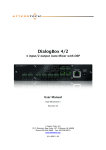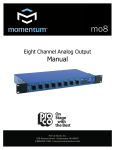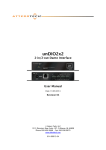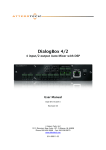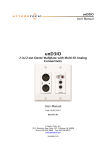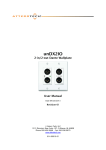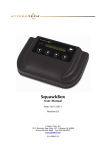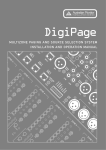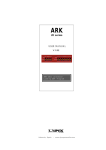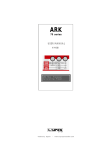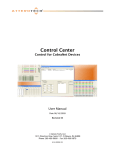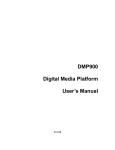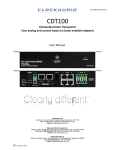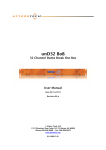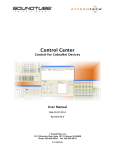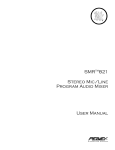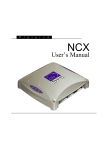Download unD4I User manual
Transcript
unD4I / unD4I-L Four Input Dante Interface User Manual Date 5/29/2015 Revision 05 Attero Tech, LLC 1315 Directors Row, Suite 107, Ft Wayne, IN 46808 Phone 260-496-9668 • Fax 260-496-9879 www.atterotech.com 614-00020-05 unD4I / unD4I-L User Manual IMPORTANT SAFETY INSTRUCTIONS The symbols below are internationally accepted symbols that warn of potential hazards with electrical products. This symbol, wherever it appears, alerts you to the presence of un-insulated dangerous voltage inside the enclosure -- voltage that may be sufficient to constitute a risk of shock. This symbol, wherever it appears, alerts you to important operating and maintenance instructions in the accompanying literature. Please read the manual. 1. 2. 3. 4. 5. 6. 7. 8. 9. 10. 11. 12. 13. 14. 15. 16. 17. 18. Read these instructions. Keep these instructions. Heed all warnings. Follow all instructions. Do not use this apparatus near water. Clean only with a dry cloth. Do not block any ventilation openings. Install in accordance with the manufacturer's instructions. Do not install near any heat sources such as radiators, heat registers, stoves, or other apparatus (including amplifiers) that produce heat. Do not defeat the safety purpose of the polarized or grounding-type plug. A polarized plug has two blades with one wider than the other. A grounding type plug has two blades and third grounding prong. The wider blade or the third prong is provided for your safety. If the provided plug does not fit into your outlet, consult an electrician for replacement of the obsolete outlet. Protect the power cord from being walked on or pinched particularly at plugs, convenience receptacles, and the point where they exit from the apparatus. Only use attachments/accessories specified by Attero Tech Use only with the cart, stand, tripod, bracket, or table specified by the manufacturer, or sold with the apparatus. When a cart is used, use caution when moving the cart/apparatus combination to avoid injury from tip-over. Unplug this apparatus during lightning storms or when unused for long periods of time. Refer all servicing to qualified service personnel. Servicing is required when the apparatus has been damaged in any way, such as power-supply cord or plug is damaged, liquid has been spilled or objects have fallen into the apparatus, the apparatus has been exposed to rain or moisture, does not operate normally, or has been dropped. This apparatus shall be connected to a mains socket outlet with a protective earthing connection. When permanently connected, on all-pole mains switch with a contact separation of at least 3mm in each pole shall be incorporated in the electrical installation of the building. If rack mounting, provide adequate ventilation. Equipment may be located above or below this apparatus but some equipment (like large power amplifiers) may cause an unacceptable amount of hum of may generate too much heat and degrade the performance of this apparatus, TO REDUCE THE RISK OF FIRE OR ELECTRIC SHOCK, DO NOT EXPOSE THIS APPARATUS TO RAIN OR MOISTURE. Attero Tech LLC 2015 Page 1 614-00020-05 unD4I / unD4I-L User Manual Note: This equipment has been tested and found to comply with the limits for a Class A digital device, pursuant to Part 15 of the FCC Rules and EN55022. These limits are designed to provide reasonable protection against harmful interference when the equipment is operated in a commercial environment. This equipment generates, uses, and can radiate radio frequency energy and, if not installed and used in accordance with the instruction manual, may cause harmful interference to radio communications. Operation of this equipment in a residential area is likely to cause harmful interference, in which case the user will be required to correct the interference at his own expense. Attero Tech LLC 2015 Page 2 614-00020-05 unD4I / unD4I-L User Manual Contents 1 – Overview..................................................................................................................................................................................................................... 4 1.1 – What’s in the Box ..................................................................................................................................................... 5 1.2 – Optional Extras......................................................................................................................................................... 5 2 – Device Installation ................................................................................................................................................................................................. 6 2.1 – Mounting .................................................................................................................................................................. 7 2.2 – Daisy Chaining and Power Linking ........................................................................................................................... 8 2.3 – Hardware Connections ........................................................................................................................................... 10 2.3.1 – Input from an Unbalanced Source ................................................................................................................. 10 2.3.2 – Input from a Balanced Source ........................................................................................................................ 10 2.4 – Logic Inputs (unD4I-L only) .................................................................................................................................... 11 2.4.1 – Analog-Input Mode......................................................................................................................................... 11 2.4.2 – Digital Input Mode ......................................................................................................................................... 11 2.5 – Logic Outputs (unD4I-L only) ................................................................................................................................. 12 2.5.1 – Sink Mode....................................................................................................................................................... 12 2.5.2 – Source Mode................................................................................................................................................... 12 3 – Device Configuration ........................................................................................................................................................................................ 13 3.1 – IP Address Setup .................................................................................................................................................... 13 3.2 – Software Installation............................................................................................................................................... 14 3.3 – Selecting a Network Adapter .................................................................................................................................. 16 3.4 – Connecting to a Device .......................................................................................................................................... 16 3.5 – Device Identification.............................................................................................................................................. 17 3.6 – Device Controls ...................................................................................................................................................... 17 3.7 – Dante Debug Mode ................................................................................................................................................ 17 3.8 – Saving and Loading Settings .................................................................................................................................. 18 3.8.1 – Internal Presets .............................................................................................................................................. 18 3.8.2 – Preset Files ..................................................................................................................................................... 18 4 – Logic Configuration (unD4I-L only) ............................................................................................................................................................ 19 4.1 – Logic Inputs ............................................................................................................................................................ 19 4.2 – Logic Outputs ......................................................................................................................................................... 19 4.3 – Logic Input Event Messaging ................................................................................................................................. 20 4.3.1 – Analog Triggered Mode ................................................................................................................................. 20 4.3.2 – Analog Timed Mode ....................................................................................................................................... 21 4.3.3 – Digital Mode ................................................................................................................................................... 21 4.3.4 – Message Payload Configuration ..................................................................................................................... 22 5 – 3rd Party Control................................................................................................................................................................................................. 23 5.1 – Command Interface Type ....................................................................................................................................... 23 5.2 – Using the Command Interface ............................................................................................................................... 23 6 – ARCHITECTS & ENGINEERS SPECIFICATION ........................................................................................................................................... 24 6.1 – unD4I A&E Specifications ....................................................................................................................................... 24 6.2 – unD4I-L A&E Specifications .................................................................................................................................... 24 7 – Device Specifications ........................................................................................................................................................................................ 25 APPENDIX A – Reference Documents ...............................................................................................................................................................A-1 Attero Tech LLC 2015 Page 3 614-00020-05 unD4I / unD4I-L User Manual 1 – Overview The unD4I and unD4I-L four input Dante interfaces are the ideal interface for adding mic/line inputs to a Dante system. They come in a small form factor with integrated mounting bracket allowing it to be mounted discretely in small spaces (such as under desks) close to the sources or sinks to reduce the amount of interference-prone analog cabling that .is required. Figure 1 - unD4I Front and Rear Panels Figure 2 - unD4I-L Front and Rear Panels Both the unD4I and unD4I-L feature four balanced mic/line inputs using 3-pin depluggable connectors for balanced or unbalanced connectivity. Each input supports eight different gain levels from -12dB to +45dB. Each input also supports a +48V phantom power option. Front panel indicators show each channel’s gain and phantom power status for easy troubleshooting. The unD4I and unD4I-L, can be powered by an external +24VDC power supply (ordered separately) but also support the use of PoE. This allows them to be powered over the network cable from a suitable PoE source (IEEE 802.3af). The PoE power option is particularly useful when mounting in a remote location where access to a mains outlet is limited or indeed, non-existent. Both product versions have two network connections to allow daisy chaining. Daisy chaining further simplifies system infrastructure wiring by allowing multiple devices that support it to use a single CAT 5 home run connection to a network switch. Power can also be daisy chained to additional devices that support power link connectors. Audinate’s Dante Controller or other 3rd party manufacturer's Dante routing software can be used to control the audio routing configuration of the device while the Attero Tech unIFY Control Panel application can be used to configure the device-specific features. Attero Tech LLC 2015 Page 4 614-00020-05 unD4I / unD4I-L User Manual Both devices also support control by third party systems allowing external configuration of its settings such as phantom power and input gain in real time. Further information on 3rd party control can be found later in this document in section 5. Additionally, the unD4I-L has support for four logic inputs and four logic outputs. These GPIO can be read and/or set via the third party control protocol. The inputs can be read either as a digital on/off or as an analog voltage between 0V and 3.3V (reported as the 12-bit ADC value in decimal). The logic inputs can also be used to trigger a customized UDP event message. There are several different event modes, selectable on an input by input basis. When an event is triggered, a custom UDP packet is transmitted to the programmed destination IP address. The logic events, message payloads and the recipient information are all configurable on an input by input basis. The logic outputs can be controlled remotely over the network using the third party control protocol or linked to mirror the digital state of one of the logic inputs. 1.1 – What’s in the Box The device comes supplied with the following o unD4I / unD4I-L device 1.2 – Optional Extras The following are available as options for the unD4I and unD4I-L that may be ordered separately: o 24 V DC power supply (P/N: 900-00175) Attero Tech LLC 2015 Page 5 614-00020-05 unD4I / unD4I-L User Manual 2 – Device Installation 1 Power LED 2 Pad active LED for each input 3 Input gain active indicators for each input 4 Phantom power active LED for each input 5 4 x Balanced audio inputs 6 (unD4I-L Only) Four logic inputs and four logic outputs 7 2 x Dante® Ethernet interface connector and indicators 8 Power Socket – Use with optional 24 V DC supply only 9 Power Link input and output *Note: All devices have a label on one of the mounting flanges shows that devices MAC address. This is important for initial device identification as the last 6 digits make up part of the devices default network name that is shown when the device is detected by Dante Controller. The MAC address is also repeated on the bottom of the unit. Attero Tech LLC 2015 Page 6 614-00020-05 unD4I / unD4I-L User Manual 2.1 – Mounting Installation of the unD4I and unD4I-L is very straight forward. It is recommended that the unit be secured to a flat surface with a screw through each mounting flange. Dimensions for mounting are show in the Figure 3 below. Use a No. 6 screw of a type and size that is applicable to the surface to which the device will be attached. Figure 3 - Mounting Information All connections should be made before the power is applied. o Attach any audio sources that will be used to the inputs. The inputs are balanced so be sure to check what output type the source to be connected uses in order to find how to connect it correctly (see Hardware Connections section). o Attach any logic devices to the logic inputs and/or logic outputs. When powering using PoE: o Attach the PoE + Data Dante I/F port to a spare PoE-enabled port on a PoE switch using a CAT-5 cable. If a midspan injector is being used, connect a spare input port to the Dante network switch using a CAT-5 cable, and then connect the corresponding output port to the PoE + Data Dante I/F of the unD4I. *Note: Using the “Data only” port connected to a PoE-enabled port on a PoE switch will not power the unit. When powering using an optional external supply: o Attach either Dante I/F port to a spare port on the Dante network switch using a CAT-5 cable. o Attach the power supply to the power input jack and then power up the external supply. If all steps are performed correctly, the power light on the front should be lit. There may also be some activity on the Dante I/F LED indicators. With no Dante network, both LEDs will remain off. If an active connection is made both LEDs will come on and if there is network activity, the yellow LED will then flash. Attero Tech LLC 2015 Page 7 614-00020-05 unD4I / unD4I-L User Manual 2.2 – Daisy Chaining and Power Linking A unique feature of the unD4I and unD4I-L are their ability to allow daisy chaining of devices. This allows units in close proximity to one another (or other devices that support daisy chaining and power linking) to utilize a single home run of Ethernet cable back to the switch thus saving on installation costs. Daisy chaining simply requires the new device be connected to the spare Ethernet port of the last device in the chain. Not only can the Ethernet connection be daisy chained, power can also be daisy chained too by connecting the power link power output on the last active device to the power link input on the new device. This works even if the initial device in the chain is powered by PoE! The number of devices that can be daisy chained is limited. The maximum that can ever be daisy chained is 6 devices in a single chain. Beyond that the number of switch hops may cause audio problems due to excessive latency and increased clock jitter. The other limitation is the power supply if power is also being daisy chained from device to device. o PoE - If power is supplied to the first device via PoE, the daisy chain limit is restricted to the initial device plus two others (trying to do more will cause the POE to over current). o Standalone – If power is supplied to the first device via a standalone supply, the supplies maximum power output determines the number of devices it can support (assume 4W @ 24V DC per device). *Note: For the unD4I-L, take care in estimating the power usage for any unD4I-L that is interfaced to logic devices. The logic outputs are capable of sinking large amounts of current. The peak power consumption of the unD4I-L when sinking all four logic outputs at its maximum sink current is ~10W (when the rear panel 24V logic supply is used). In applications where the unD4I-L is used, it is recommended to use local power supplies and avoid daisychaining where possible to simplify the potential power supply issues. To daisy chain a device, connect an Ethernet cable from the data only port of the powered unit to one of the ports of the device to be chained. This supplies the network information only. To chain the power, connect the “Link out” connector of the powered unit to the “Link in” connector on the device to be chained. If the second unit is another unD4I, a third unit could be chained by connecting it in the same way to the second unit and so on. Network Configuration Note: If the devices are installed in a networked daisy-chain topology, it is highly recommended to only configure unicast flows from each of the devices' Dante transmitters in the chain. The addition of multicast flows along the daisy chain can overwhelm the switches in the chain with unnecessary multicast audio traffic resulting in potential latency and network clock synchronization issues, especially on the units installed at the end of the daisy-chain network segment. Additionally, if there are a significant number multicast audio flows configured on the Dante network, it is recommended that the core network switches that interface to the daisy-chained network segments be configured with the appropriate IGMP settings to shield the chain from unnecessary multicast audio traffic. The example shown in Figure 4 highlights how an IGMP enabled switch can eliminate unnecessary multicast audio traffic from the unD4I daisy chain segment. The red connections show devices that are configured for multicast audio flows and the green are unicast flows and each show the network segments that are traversed by the associated audio traffic. Attero Tech LLC 2015 Page 8 614-00020-05 unD4I / unD4I-L User Manual Figure 4 - Network Configuration Example Attero Tech LLC 2015 Page 9 614-00020-05 unD4I / unD4I-L User Manual 2.3 – Hardware Connections The unD4I and unD4I-L accept unbalanced or balanced audio from source devices. Refer to the following diagrams and instructions for connecting different types of audio devices. Professional grade audio cabling is recommended to achieve the best audio performance throughout the system. *Note: The following diagrams refer to the unD4I but apply equally to the unD4I-L as well. 2.3.1 – Input from an Unbalanced Source To connect a 2-wire unbalanced source to the unD4I, connect the positive output of the unbalanced source to the positive input of the unD4I. Connect both the source and unD4I input grounds together, and short the negative input of the unD4I to ground at the input of the unD4I. Figure 5 - 2-Wire Unbalanced Source Connection To connect unbalanced sources with a 3-wire connection, short the negative conductor to the shield at the source connection. Figure 6 - 3-Wire Unbalanced Source Connection 2.3.2 – Input from a Balanced Source To connect balanced sources to the unD4I, connect positive output to positive input, negative output to negative input, and connect the grounds together through the cable shield. Figure 7 - Balanced Source Connection Attero Tech LLC 2015 Page 10 614-00020-05 unD4I / unD4I-L User Manual 2.4 – Logic Inputs (unD4I-L only) The logic inputs of the unD4I-L can be used as analog inputs to measure a voltage or as digital inputs. In either case the maximum input voltage must be between 0V and 3.3V. The input connections provide both a ground reference and a 3.3V supply. The current limited 3.3V supply connection is provided on the rear panel near the logic inputs for easy access. Note also that only a single ground is required for logic input signals originating from the same device. All programmable logic input feature configuration is performed using the unIFY Control Panel software. Figure 8 - Logic I/O Pinout 2.4.1 – Analog-Input Mode When used as an analog input, the voltage applied must be between 0V and 3.3V. The unD4I-L will convert that into a 12-bit number where 0 = 0V and 4095 = 3.3V. A typical application for using an analog input may be a volume control where the volume is controlled by a potentiometer. The position of the potentiometer can be measured by the unD4I-L and a control system can read the value and adjust the volume accordingly. Figure 9 - Analog Mode Interfacing 2.4.2 – Digital Input Mode When the logic inputs are used as digital inputs, the input turns on when the input voltage rises above 1.85V and will turn off again when the voltage falls below 1.2V. Typical drive circuits could be simple switches or open collector and push-pull logic outputs from another device. Figure 10 - Digital Mode Interfacing A typical use case for the logic inputs are the use of a latching switch used to indicate the mute state of the microphones interfaced to the unD4I-L to a networked audio DSP (or control system) in the audio system. When the end user closes the switch a network message cab be configured to be sent to the DSP. When the switch closes or opens, the change in mute state is indicated back to the DSP or control system. Attero Tech LLC 2015 Page 11 614-00020-05 unD4I / unD4I-L User Manual 2.5 – Logic Outputs (unD4I-L only) The logic outputs can be used to drive external indicators or devices. The outputs can be driven directly from a 3rd party control system or can be linked to the digital state of one of the unD4I-L inputs. The logic inputs feature two operational modes that can be configured based upon the physical configuration of the logic output interface. 2.5.1 – Sink Mode The logic outputs can be used to indicate the logic state in a sink mode configuration. This mode is optimized for driving moderately heavy loads such as relay coils. In this mode, the outputs can sink up to 50mA from a 5V to 24V power supply. When the logic outputs are wired in this mode, the logic outputs will work as active-low outputs when integrated with the 3rd party control protocol or the unIFY Control Panel software. Figure 11 - Sink Mode Examples *Note: If used with an inductive load such as a relay, an external freewheeling diode must be placed across the logic output and the supply connection. Use a 1N4004 or similar diode for this application. The unD4I-L has an in-built, current limited 24V DC supply connection available on the rear panel terminal block. This supply connection is not intended to be used to supply power to other devices. Additionally, the use of an external supply is also supported. 2.5.2 – Source Mode In the source mode configuration, the logic outputs can be used to source 5V at up to 20mA for direct connection to LEDs or other logic devices. Figure 12 - Source Mode Example When the logic outputs are wired in this mode, the logic outputs will work as active-high outputs when integrated with the 3rd party control protocol or the unIFY Control Panel software. Attero Tech LLC 2015 Page 12 614-00020-05 unD4I / unD4I-L User Manual 3 – Device Configuration There are two parts of the device that require software to setup. First the audio routing, and second the configurable features of the device itself. The audio routing should be carried out using Audinate’s Dante Controller. This can be obtained from the Audinate website (www.Audiante.com). Instructions on how to use this software and about setting up routes on a Dante network can also be found on their website. *Note: When using Dante controller, the unD4I will be shown using a default device name of “unD4I-######” where ‘######’ is the last six characters of the devices MAC address. Similarly, the unD4I-L will be shown as “unD4I-L-######”. Configuration of the unD4I and unD4I-L specific features is carried out using the Attero Tech unIFY Control Panel application. This application is available from the Attero Tech website (http://www.atterotech.com/products/unifycontrol-panel/). It should be used to examine and modify the device specific features such as mic/line gain level, and phantom power settings and in the case of the unD4I-L, the logic IO settings. *Note: Support for the unD4I-L is provided from unIFY Control Panel V1.6 onwards. 3.1 – IP Address Setup ******************************************************* IMPORTANT **************************************************** Failure to correctly configure IP addresses will not allow an unD4I or unD4I-L device to correctly authenticate in the unIFY Control Panel software and while it will show up in Dante Controller, the input and output channels won’t be visible and routing of audio to and from the device will not be possible. **************************************************************************************************************************** In order to configure an unD4I or unD4I-L, both to set up internal parameters and also setup audio routing, the PC will need to be able to communicate with the devices over the network. While all Dante devices will be discovered regardless of the IP address setup on the PC, communication can only occur if the PC and the device have compatible IP addresses. By default, unD4I and unD4I-L are set to get a dynamic IP address. As with all Dante devices, if the unD4I or unD4I-L does not find a DHCP server to retrieve an IP address from, it will give itself an local link address sometimes also known as an automatic private IP address (APIPA) instead. A local link IP address is always in the range 169.254.x.y. To ensure communication, the PC can either be set to get a dynamic IP address, or be given a static IP address in the range 169.254.x.y. The PC may require a restart for the IP address changes to take effect. In some applications, IP addresses of devices may need to be set to something specific and that can be done once initial communication has been established. Bear in mind however that if a static IP address is assigned to a device and that static IP address is in a different range to the IP it was previously using to communicate with the PC, the PC will lose communication with the device until such time as the PC’s IP address is also changed to an IP in the new range. Further information on IP setup for an audio system using Dante can be found in the FAQ’s on the Audinate website (https://www.audinate.com/resources/faqs). Attero Tech LLC 2015 Page 13 614-00020-05 unD4I / unD4I-L User Manual 3.2 – Software Installation After downloading the application, run the .exe and the first screen to appear will be the license agreement and options screen. The software will install to a default location of c:\program Files (x86)\Attero Tech\unIFY Control Panel. Clicking the “Options” button allows the user to change the installation location if required though it’s not necessary to change it. To select a new installation location, either type in a new path in the edit box, or click on the “Browse” button to browse the folder tree for the desired installation location. Once complete, click the OK button to return to the previous screen. To continue the install, read the license agreement and check the “I agree…” check box. Doing so enables the “Install” button. Click the now enabled “Install” button to start the installation of the files. On Windows Vista or later if the PC has the UAC enabled, a warning pop up will now appear saying the installer is about to make changes to your PC. This needs to be accepted for the installation to complete successfully. The installer will show a progress screen and will now being transferring files to your PC. Once the files are transferred, the installer will show a completion message show whether the installation was successful or not. Attero Tech LLC 2015 Page 14 614-00020-05 unD4I / unD4I-L User Manual If the installation was unsuccessful for any reason, the final screen will show an error message. Attero Tech LLC 2015 Page 15 614-00020-05 unD4I / unD4I-L User Manual Once the required software is installed, click on the unIFY Control Panel icon in the programs list under Attero Tech. This will start the application. Figure 13 - Device Configuration Window 3.3 – Selecting a Network Adapter In order to connect to a device the application needs to know what network adapter it should use to contact devices. Clicking on the networked PC icon will show a list of all possible adapters. *Note: Only network adapters that are deemed as being compatible with Dante will be shown in the list. 3.4 – Connecting to a Device A few seconds after selecting the adapter, the device list should start to populate with detected devices. The detected devices are listed by their device name. Select the device to be configured from the drop down list and then click the “Connect” button. The application will then attempt to establish a connection with the device. If successful, the status bar will show “Connected” and the controls will become active and their values will update to show the current state of the device. Figure 14 - unD4I / unD4I-L settings *Note: The “Logic Configuration” button will only be displayed if the device that is connected is an unD4I-L. The labels below the controls show the channel name as displayed in Dante Controller. The channel name cannot currently be set from within the unIFY application. To change the channel names, use Dante Controller. This connected device is now treated as the active device and any changes to the controls will be set to this device and this device alone. Attero Tech LLC 2015 Page 16 614-00020-05 unD4I / unD4I-L User Manual 3.5 – Device Identification The device identification feature allows the user to see which device is physically being configured. When the Identify feature is active, the power LED on the active device will flash. The Identify check box shows the state of the device identify feature. If the box is checked, the feature is active on the active unit. If the check box is clear, the identify feature is inactive. To change the state of the feature, simply click in the Identify check box to toggle its state from off to on or on to off. The identify function will continue to operate until the function is turned off via the user interface or the device is powered down. *Note: The identify function of Dante Controller does not control the identify feature on the unD4I. To identify a device use the unIFY Control Panel identify function instead. 3.6 – Device Controls The device inputs have two software configurable options per input. The mic/line gain control and the phantom power control. The mic/line gain control gives the user eight gain choices depending on the type of signal being provided to the input. A line level signal should typically use the 0dB option. Choose the gain value that best suits the level of the incoming signal. Changing this setting sets both the gain, level and whether the -12dB pad is active depending on what level is selected. The new gain will also be indicated on the status LED’s on the front panel. The phantom power option is available for microphones that need it. The unD4I provides 48V phantom power. Check the box to turn phantom power on. Uncheck the box to turn it off. 3.7 – Dante Debug Mode Dante debug mode uses the front panel LED’s to show the Dante diagnostic status. This is active initially on power up for approximately 20 seconds before switching to show the gain and phantom power settings. However, if network or audio problems persist, the debug feature can be re-enabled manually by checking the Dante Debug mode check box. When in debug mode, the gain status for each input is disabled and instead the current Dante diagnostic states are shown instead on the left-hand columns (labeled is “Pad” and “+15”). The tables below show what each set of LED’s mean. CH4 - SYS System booting Identify (all Pad LED’s flashing) System ready (Activated through the Identify function of Dante Controller) CH1 – SYNC PTP currently syncing PTP error / no PTP sync / PTP disabled PTP Slave, with PTP sync PTP master CH3 – ERR Capability is corrupted Memory stack overflow Attero Tech LLC 2015 Page 17 614-00020-05 unD4I / unD4I-L User Manual 3.8 – Saving and Loading Settings The device settings can be saved or loaded by clicking on the icon to bring up the preset form. Figure 15 - Configuring Presets Dialog The unD4I and unD4I-L both support 10 internal presets with one of those presets used as the power-up default. It also supports saving settings to, and loading settings from, a file for transferring to another device or for backup purposes. 3.8.1 – Internal Presets Settings in a device can be saved to an internal preset which can then be recalled at a later date. There are 10 internal presets, one of which is the “Default” preset that is used to set device settings when the device is first powered on. Select a preset to use by using the drop down in the Device Preset section. Once a preset has been selected, the current settings of the device can be saved to the selected preset by clicking the “Save to Device” button. Alternately, the settings from the selected preset can be loaded and used as the current settings by clicking the “Recall from Device” button. *Note: Loading a preset will overwrite all the current settings in the device with settings from the selected preset. The GUI will also update to show these new settings overwriting all of its settings. 3.8.2 – Preset Files To allow settings to be transferred to others devices or for use as a backup, the current settings can also be saved to a file or loaded from a file. When loading settings from a file, both the on-screen controls and the device settings will be modified to match the settings from the file. If the settings from the file need to be saved to a preset, then that will need to be done manually once the settings are loaded. To save the current settings to a file, click the “Save to File” button and then enter an appropriate filename. To load settings from a file, click the “Load from File” button and select the appropriate file. Attero Tech LLC 2015 Page 18 614-00020-05 unD4I / unD4I-L User Manual 4 – Logic Configuration (unD4I-L only) The logic inputs and outputs are configured from a dedicated dialog that is accessible only when the GUI is connected to an unD4I-L. This is done by clicking on the “Logic Configuration” button which will be visible when an unD4I-L is connected. Figure 16 - Logic Configuration Form 4.1 – Logic Inputs The Logic Input section displays the state of each logic input. Both the digital state (green for on, grey for off) and analog value represented as voltage for each of the four logic inputs are shown. The GUI continuously retrieves this information while the form is open showing changes to the values and states in real-time. 4.2 – Logic Outputs The Logic Output section shows both the current state of the output as well as allowing control of what the output does. For each output there is a State, an On/Off control and a Link To option. The “State” indicator shows the current output state whether it be on (green) or off (grey). This is updated continuously to give a real-time indication of the output state. The “On/Off” control allows manual control of the output and is typically used for testing purposes. This control is disabled if the output is linked to an input (see below). The “Link To” option allows the output state to mirror one of the unD4I-L’s inputs. When linked, the output state will automatically turn on and off depending on the state of the input it is linked to. While this linking feature is enabled, manual operation of the output using the “On/Off” controls is disabled. Attero Tech LLC 2015 Page 19 614-00020-05 unD4I / unD4I-L User Manual 4.3 – Logic Input Event Messaging Each logic input can be set up to generate UDP messages upon certain events. The Logic Input Configuration section is used to configure the mode of events that initiate the message to be sent, where the customized message is sent to as well as the contents of the messages. Each of the logic inputs have their own configuration which are accessed by clicking on the associated tabs for each logic input channel. *Note: Settings for this section are only applied after the Apply button is pressed. This will apply settings for all channels. There are three different modes for the message events, analog triggered mode, analog timed mode and digital mode. The event mode is configured using the “Mode” drop-down box. Details of operation of each mode and the additional parameters each particular mode uses are found below. 4.3.1 – Analog Triggered Mode In analog triggered mode, the unD4I-L takes the maximum analog range for an input (0-4095) and subdivides it into a number of approximately equal sized steps determined by the "Analog Steps" field. There can be as few as 2 steps up to a maximum of 256. Using the analog voltage reading on the input, the unD4I-L determines what step the input is currently on and whether the current step has changed from the last time the input value was read. If it determines the step is now different, an event message is generated containing the current step level. The configurable step size allows the event messages to be tailored for the device that will be interpreting the control. Additionally it helps minimize the number of event message packets that are sent by the unD4I-L as the analog input voltage changes. Figure 17 – Analog (Triggered) Mode Controls For example, take the message setup as configured in Figure 17. The “Analog Steps” setting is at 100 so each step size equate to 4096 / 100 = 40.96. This is rounded up to 41. If the volume starts out at a value of 150, that is in step 3 as it’s between the values 123 (41 * 3) and 164 (41 * 4). While the voltage remains in that range, nothing happens. However, if the value were to increase to above 164 to say 170, it is now in the next step level, and a UDP event message will be sent to port 55555 at IP address 169.254.0.200 with contents of “VOLUME 4<CR>”. On the other hand, if the input voltage were to decrease to 100, that is now below the previous step value of 123 (41 * 3), it is now in step 2 and that is now a different step level and a UDP event message will be sent to port 55555 at IP address 169.254.0.200 with contents of “VOLUME 2<CR>” A typical use case for this mode would be a graduated volume control. Attero Tech LLC 2015 Page 20 614-00020-05 unD4I / unD4I-L User Manual 4.3.2 – Analog Timed Mode In analog timed mode, the event messages will be sent at a rate configured in the “Analog Time” field. The acceptable range for the “Analog Time” field is 0.1 to 10 seconds. The raw value of the 12-bit A/D converter is appended to each event message. Figure 18 - Analog Timed Mode Controls As an example, the event message configured in Figure 18 would result in a UDP event message being sent to port 55555 of IP address 169.254.0.200 every tenth of a second where the data payload of the message would range from VOLUME 0<CR> to 4095<CR> depending on the current input level. 4.3.3 – Digital Mode The digital mode allows for triggering an event message when the digital state of the input changes. The valid triggering options are rising, falling, or both. By selecting the triggering mode, once the unD4I-L detects a logic state change an event message is sent based on the selecting triggering mode. Subsequently, selection of the trigger type will enable the valid event message string fields. Figure 19 - Digital Mode Controls As an example, the event message configured in Figure 19 would result in a UDP event message to be sent to UDP port 55555 of IP address 169.254.0.200 every time Input 1 changes its digital state. If the state changes from low to high, a “MUTE ON<CR>” message is sent. If the state changes from high to low, a MUTE OFF<CR> message is sent. An application example for this feature is the use of the unD4I-L to communicate the mute state of a connected microphone's switch setting to a DSP or control system that exists on the network. Attero Tech LLC 2015 Page 21 614-00020-05 unD4I / unD4I-L User Manual 4.3.4 – Message Payload Configuration For all analog and digital event modes, once a mode has been selected and configured, the data payload of event message needs to be configured. This requires entry of one or more data fields for the message itself and a common termination field which is used on the end of every message. There are three messages fields that may need to be entered depending on the event mode selected. The "Analog" message text field is required when either of the analog event modes is selected. The “Digital High” and/or “Digital Low” message text fields are required when the digital event mode is selected. The type of digital mode event determines whether one, the other or both these particular messages are required. Regardless of the type of the message field, each must contain an ASCII string of at least one or more characters up to a maximum of 32 characters. A termination string for messages is also required. The termination string appended to all event messages and is an ASCII string of up to 8 characters. There is an option to include a CR (Carriage Return), a LF (Line Feed), or both in the termination string if required. The termination string must contain at least one character if both the CR or LF options are not required. To complete the event message setup, the details for the recipient device needs to be configured so the unD4I-L knows where to send the messages to. This requires a valid IP address and a valid port number (1-65535) to be entered of the device where the event messages are going to be sent. To save the settings to the active device, press the “Apply” button. The save will store the current GUI settings assigned to all four logic input channels events at the same time. Attero Tech LLC 2015 Page 22 614-00020-05 unD4I / unD4I-L User Manual 5 – 3rd Party Control The unD4I and unD4I-L support 3rd party control allowing external system to manage the devices settings such as phantom power, mic/line gain options and control of presets. For the unD4I there are two control interface types available. The first type is a Dante proprietary interface which is typically used by devices already that have built-in support for Attero Tech devices. The second type supports a 3rd party UDP interface and is available to anyone to use with any device capable of sending and receiving UDP messages. The unD4I-L is only offered with the 3rd party UDP interface option. Information on the commands each device supports as well as details of how to use the 3rd party UDP interface can be found in the unIFY 3rd party Software API document, available from the registered users section of the Attero Tech website (Go to www.atterotech.com and click on the “log-in” option). 5.1 – Command Interface Type The type of command interface a specific device supports is defined by the Dante firmware it has been loaded with. There are two methods to determine which Dante firmware and thus which command interface that is: 1) Run unIFY Control Panel V1.5.1 or later and connect to a device. The interface type is shown on the status bar at the bottom of the application window as the “Direct UDP” setting. A “No” means the device is using the Dante Proprietary interface. A “Yes” means the device is using the 3rd party UDP interface. 2) Using Dante Controller, look at the devices “Product Version” by double-click on the device in question, select the “Status” tab and look for the “Product Version” parameter. In either case, the device is using the Dante Proprietary interface if the product version either is V1.x.x or the product version is V4.0.0 or later and the firmware version is V1.0.0. If the product versions is V2.0.0 or V3.0.0 or the product version is V4.0.0 or later and the firmware version is V2.0.0, then the device is using the 3rd party UDP control interface. A device’s command interface can be changed simply by updating the device’s Dante firmware. Moreover, this can be done in the field in almost all cases. The tools and necessary firmware files for updating a device’s command interface can be obtained from the registered users section of the Attero Tech website (Go to www.atterotech.com and click on the log-in option). The firmware files have an extension .DNT (otherwise known as “donut” files) and there is one for each command interface type. The firmware file with the lower of the two version numbers supports the Dante proprietary interface while the one with the higher version number supports the 3rd Party UDP interface. 5.2 – Using the Command Interface In order to make use of the command interface, regardless of type, the unD4I simply needs to be configured with an IP address that is compatible with the device doing the controlling. The control devices should then be able to converse with the unD4I without any further configuration necessary. The same IP address requirements apply to the unD4I-L for successful communication over the UDP command interface. Attero Tech LLC 2015 Page 23 614-00020-05 unD4I / unD4I-L User Manual 6 – ARCHITECTS & ENGINEERS SPECIFICATION 6.1 – unD4I A&E Specifications The Dante interface unit shall provide four mic/line analog inputs on the rear panel via 3-pin depluggable connectors. Selectable gains of 0dB, +15dB, +30dB, and +45dB and a +48V phantom power option shall be provided via software for each input. The unit shall provide two RJ-45 network connectors to allow Dante Daisy Chaining (DDC) of multiple units. The internal analog to digital signal conversion shall be performed at 24-bit resolution with a sampling frequency of 48kHz. The Dante interface unit shall receive power over the Ethernet cable from an IEE 802.3af compliant network switch or from an external +24V supply. The Dante interface unit shall be compatible with Attero Tech unIFY software for flexible control and monitoring in system applications. The Dante interface shall be compliant with the RoHS directive. The Dante interface unit shall be Compliant with the EMI/EMC requirements for FCC and CE. The Dante interface unit shall be the Attero Tech unD4I. 6.2 – unD4I-L A&E Specifications The Dante interface unit shall provide four mic/line analog inputs on the rear panel via 3-pin depluggable connectors. Selectable gains of 0dB, +15dB, +30dB, and +45dB and a +48V phantom power option shall be provided via software for each input. The unit shall provide two RJ-45 network connectors to allow Dante Daisy Chaining (DDC) of multiple units. The internal analog to digital signal conversion shall be performed at 24-bit resolution with a sampling frequency of 48kHz. The Dante interface unit shall receive power over the Ethernet cable from an IEE 802.3af compliant network switch or from an external +24V supply. The Dante interface shall have four logic inputs and four logic outputs. The logic outputs shall be programmable such that customized network messages can be sent on detection of logic input state changes. The logic inputs shall be also be capable of operating in an analog mode to report changes in voltage input levels with customized network messages. The logic outputs shall be capable of sinking up to 50mA when interfaced to a 24V supply or sourcing up to 20mA @ 5V. The logic output states shall be remotely controlled by software. The Dante interface unit shall be compatible with Attero Tech unIFY software for flexible control and monitoring in system applications. The Dante interface shall be compliant with the RoHS directive. The Dante interface unit shall be Compliant with the EMI/EMC requirements for FCC and CE. The Dante interface unit shall be the Attero Tech unD4I-L. Attero Tech LLC 2015 Page 24 614-00020-05 unD4I / unD4I-L User Manual 7 – Device Specifications Dante Network Audio Inputs Input Type: Gain: Input Impedance: Balanced and RF filtered Physical Level: Standard Ethernet 0dB, +15dB, +30dB and +45dB, software selectable Connector: Single RJ-45 Cable Quality: CAT-5 Transmission Speed: 100 Mbps 12dB pad, software selectable >1.8K ohms at any gain +8dbU @ 0dB gain, Power Requirements -7dBu @ +15dB gain, +24V DC -22dBu @ +30db gain Maximum Input Levels: 4.9W Max (unD4I) -37dBu @ +45dB gain without pad With 12dB pas, maximum input levels are 12dB higher Phantom Power: Class 0 802.3af PoE PD compliant Power Consumption +48V, software selectable Audio Performance 10W Max (unD4I-L, all logic outputs active in sink mode supplied interfaced to onboard 24V logic supply) 4.9W Max (unD4I-L w/no active logic I/O) EIN: -115dBu System THD+N: <0.01% at any gain, input signal 3dB below maximum Dimensions 8.32” W x 1.50” H x 4.74” D Frequency Response 20Hz – 20kHz, +/- 1dB Weight 1.7lbs Logic I/O (unD4I-L only) Inputs FCC CFR 47 Parts 15B 4 Inputs, 0 to 3.3V input voltage range, software configurable for analog or digital operational modes Compliance ICES-003 CE (EN55022) RoHS 4 Outputs, 50mA sinking capability Outputs (5V to 24V external supply) 20mA @ 5V sourcing capability Attero Tech LLC 2015 Page 25 614-00020-05 unD4I / unD4I-L User Manual APPENDIX A – Reference Documents The following table lists the relevant reference documents. Document Title Location unIFY 3 Party Software API Registered users area on website Dante Firmware Update Quick Start Registered users area on website rd Attero Tech LLC 2015 Page A-1 614-00020-05




























